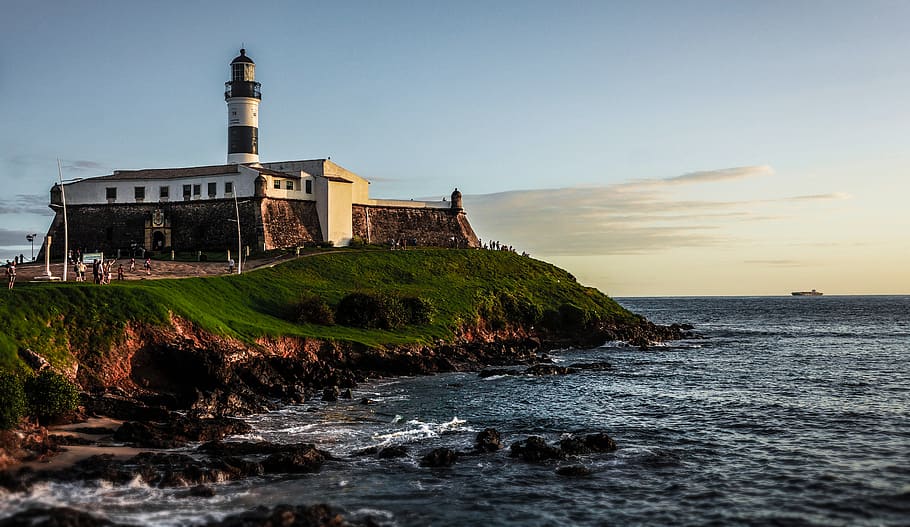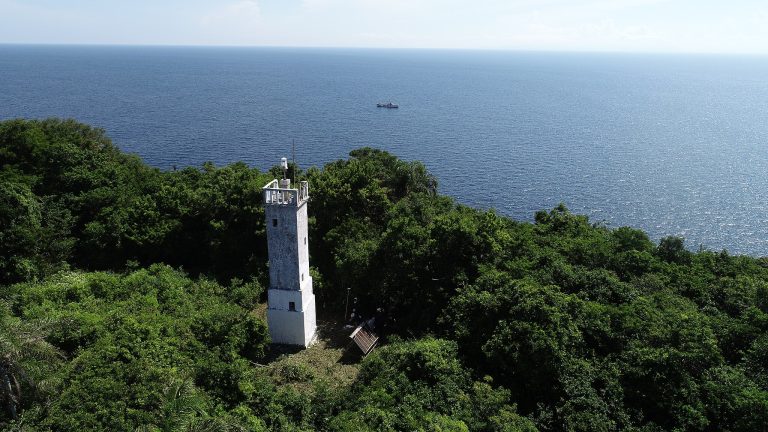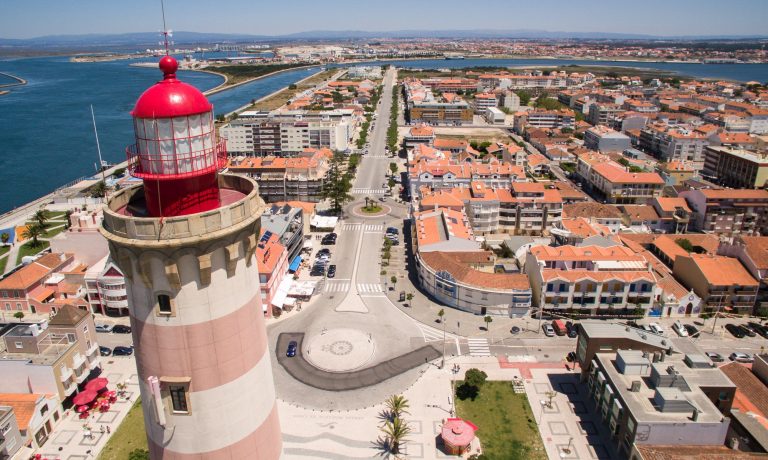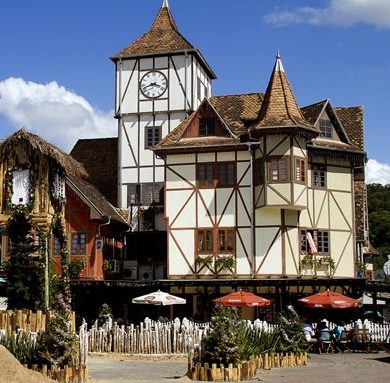Brazil, with the longest coastline in South America, boasts 9,655 kilometers of shoreline along the Atlantic Ocean. Along this extensive coast, numerous lighthouses, known as “farol” in Portuguese, stand as sentinels guiding ships safely to shore. These beacons, often shrouded in stories and legends, offer fascinating insights into Brazil’s maritime heritage and culture. Let’s explore some of the most significant lighthouses along the Brazilian coast.
A Glimpse into Brazil’s Coastal Treasures
The Brazilian coast, though extensive, is remarkably uniform. However, it features coves and large sheltered bays that form perfect natural harbors. Mariners and the coast guard rely on lighthouses in these areas to navigate safely. Notable bays include Guanabara Bay in Rio de Janeiro, overlooked by Christ the Redeemer, and the Bay of All Saints (Bahia de Todos os Santos) in Salvador de Bahia. At the entrance of the latter stands the Farol de Santo Antônio, also known as Barra Lighthouse.
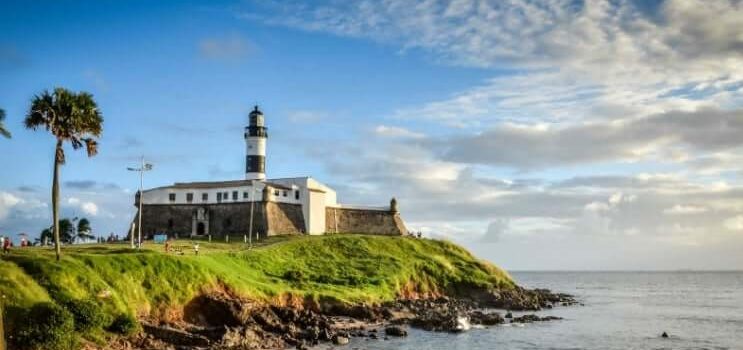
Barra Lighthouse: A Historical Beacon
The Barra Lighthouse, located atop a 22-meter-high tower at Fort Santo Antônio da Barra, was the second lighthouse established on the Americas’ coast and the oldest still standing. Built in 1698, it initially featured a bronze lantern fueled by whale oil. The lighthouse underwent modernization in 1839 and again in 1939 when it switched to an electric lantern on its centenary. This iconic structure has inspired many Bahian poets and artists. Today, it is a crucial part of the panoramic city tour of Salvador de Bahia, attracting numerous visitors. The fort also houses the Nautical Museum of Bahia, established in December 1998, offering rich maritime history.
Palácio das Torres: The First Lighthouse in the Americas
The first lighthouse in the Americas was Brazilian, located in Recife. Built between 1639 and 1642 by Dutchman Johan Maurits van Nassau-Siegen, it featured a simple lantern and an astronomical observatory in its towers. Known as Palácio das Torres, it was abandoned after the Dutch left Brazil and was destroyed in 1787. However, a virtual model exists, preserving its historical significance.
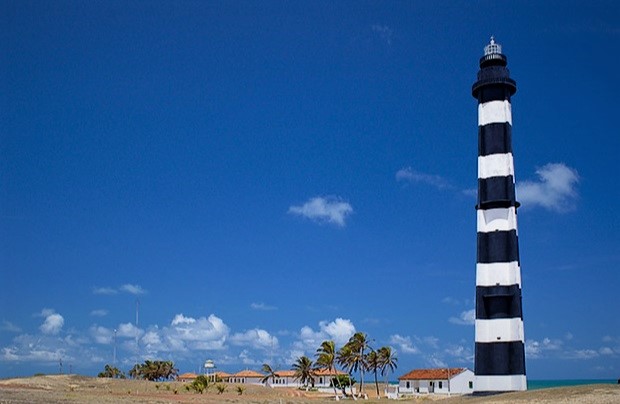
Farol do Calcanhar: A Strategic Lighthouse
Farol do Calcanhar, meaning “Lighthouse of the Heel,” is situated at the “angle” of the Brazilian coast between north and south. It stands 62 meters tall, making it the fourth largest lighthouse in Latin America and the 22nd tallest in the world. Its strategic location is crucial for navigation along Brazil’s extensive coastline.
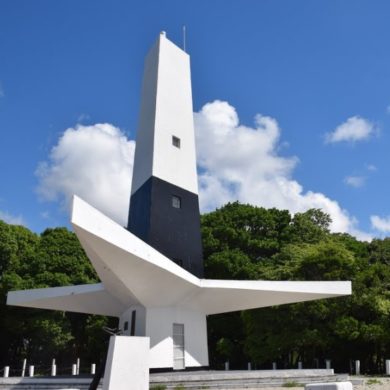
Farol do Cabo Branco: Architectural Marvel
Located 800 meters from the easternmost point of mainland Brazil, Ponta do Seixas in João Pessoa, Farol do Cabo Branco is known for its unique triangular architecture. Designed by architect Pedro Abraão Dieb, the structure symbolizes the sisal plant, a significant regional economic resource. This lighthouse stands out for its design and its critical navigational role.
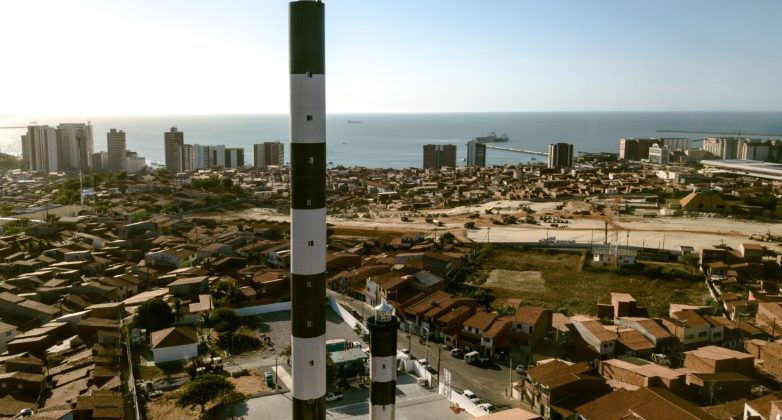
Farol de Mucuripe: The Tallest Lighthouse
At 73 meters high, Farol de Mucuripe in Fortaleza is the tallest lighthouse in Brazil and the Americas. Inaugurated in 2017 after a restoration project, it replaced the previous 24-meter structure. This lighthouse is a gateway for tourists exploring the Ceará coastline and its stunning beaches, such as Jericoacoara, or embarking on the famous “Route of Emotions” tour.
Vassouras Lighthouse: A Picturesque Guide
During the Route of Emotions tour, which passes through Jericoacoara, the Parnaíba Delta, and the Lençóis Maranhenses desert, visitors encounter the charming Vassouras Lighthouse. In this region, where fishermen sail far offshore on simple skiffs or “jangadas” without modern navigation tools, these lighthouses are vital for their safe return to shore.
The Lighthouse on Snake Island
One of the most intriguing and remote lighthouses in Brazil is located on Ilha da Queimada Grande, also known as Snake Island. This island is infamous for its dense population of venomous golden lancehead pit vipers, making it one of the most dangerous places on earth. The lighthouse, built in 1909, was operated manually until the island’s deadly inhabitants made it too hazardous for lighthouse keepers. It has since been automated. This lighthouse is crucial for navigation, warning ships away from the treacherous island. The tales of Snake Island, combined with the eerie isolation of the lighthouse, make it a fascinating point of interest for maritime enthusiasts.
Preservation and Recognition of the Brazilian Lighthouses
Although no Brazilian lighthouses are recognized by UNESCO, the Brazilian government ensures these historic landmarks are well maintained and receive the recognition they deserve. These beacons are not just navigational aids but also cultural and historical treasures that tell the story of Brazil’s maritime heritage.
The Cultural and Historical Significance
Lighthouses in Brazil are more than navigational aids; they are monuments of historical and cultural significance. They have witnessed centuries of maritime activity and stand as testaments to Brazil’s rich seafaring traditions. Each lighthouse has its unique story, from the early days of whale oil lanterns to modern electric lights guiding ships safely through treacherous waters.
Exploring Brazilian Lighthouses
For those interested in maritime history and architecture, visiting these lighthouses offers a fascinating glimpse into Brazil’s coastal life. The Barra Lighthouse, with its panoramic views and historical museum, provides insights into the nautical history of Salvador de Bahia. Farol do Calcanhar and Farol do Cabo Branco offer unique architectural styles and strategic importance. The towering Farol de Mucuripe stands as a modern marvel, while the Vassouras Lighthouse adds a picturesque touch to the Route of Emotions.
Stories and Legends of Brazilian Lighthouses
Many Brazilian lighthouses are steeped in legends and folklore, adding an air of mystery and romance to these coastal sentinels. For example, the Barra Lighthouse is said to be haunted by the spirits of sailors who perished in shipwrecks nearby. Locals tell tales of ghostly apparitions and strange noises emanating from the lighthouse on stormy nights. In contrast, the Farol do Cabo Branco is celebrated for its role in numerous rescue missions. Fishermen and sailors often recount stories of how the lighthouse’s guiding light saved them from treacherous waters and brought them safely to shore. These stories not only highlight the practical importance of the lighthouses but also their place in the cultural fabric of coastal communities.
The Role of Lighthouses in Modern Navigation
While modern technology such as GPS and electronic navigation systems have reduced the reliance on traditional lighthouses, these structures still play a crucial role. They serve as vital backup systems, providing visual cues to mariners and ensuring safe passage along the coast. Lighthouses also assist in search and rescue operations, helping to locate vessels in distress. The Brazilian Navy and other maritime authorities regularly inspect and maintain these lighthouses to ensure their functionality. In addition, advancements in lighting technology have allowed for the installation of more efficient and powerful lights, enhancing the visibility of these beacons.
Lighthouse Tourism in Brazil
Lighthouse tourism is an emerging trend in Brazil, attracting visitors who are fascinated by these historic structures and their stunning coastal locations. Many lighthouses are situated in picturesque settings, offering breathtaking views of the ocean and surrounding landscapes. Guided tours provide visitors with insights into the history and operation of the lighthouses, as well as the opportunity to climb to the top and enjoy panoramic vistas. For example, the Barra Lighthouse offers guided tours that include a visit to the Nautical Museum of Bahia, where exhibits showcase maritime artifacts and historical documents. Similarly, the Farol do Cabo Branco features an interpretive center that educates visitors about the lighthouse’s unique architecture and its role in local navigation.
Educational and Cultural Programs
In addition to tourism, several Brazilian lighthouses host educational and cultural programs aimed at preserving maritime heritage. Schools and community groups frequently visit these sites to learn about the history of navigation, the science of light, and the importance of maritime safety. These programs often include hands-on activities, such as building miniature lighthouse models and participating in mock search and rescue exercises. The Brazilian government and non-profit organizations collaborate to fund and organize these educational initiatives, recognizing the value of lighthouses as cultural and historical landmarks. Through these efforts, they aim to inspire a new generation of maritime enthusiasts and ensure the continued preservation of Brazil’s lighthouse heritage.
The future for Brazilian Lighthouses
Looking ahead, the future of Brazilian lighthouses appears bright. (Pun intended!) Ongoing efforts to restore and maintain these historic structures, coupled with growing interest in lighthouse tourism, suggest that these beacons will continue to play a significant role in Brazil’s coastal landscape. Technological advancements will further enhance their functionality, while educational and cultural programs will keep their stories alive for future generations.
An Invitation to Explore
The lighthouses of Brazil offer a unique window into the country’s maritime history and culture. Each lighthouse, with its distinctive architecture, strategic location, and rich heritage, tells a story of bravery, innovation, and resilience. For travelers seeking to delve deeper into Brazil’s coastal treasures, a visit to these lighthouses promises an enriching and memorable experience. Embark on a journey along Brazil’s coast to discover these fascinating lighthouses, each with its own unique charm and history. Whether you are a history enthusiast, architecture lover, or simply seeking a scenic adventure, the lighthouses of Brazil offer a compelling reason to explore the nation’s extensive and beautiful coastline.
